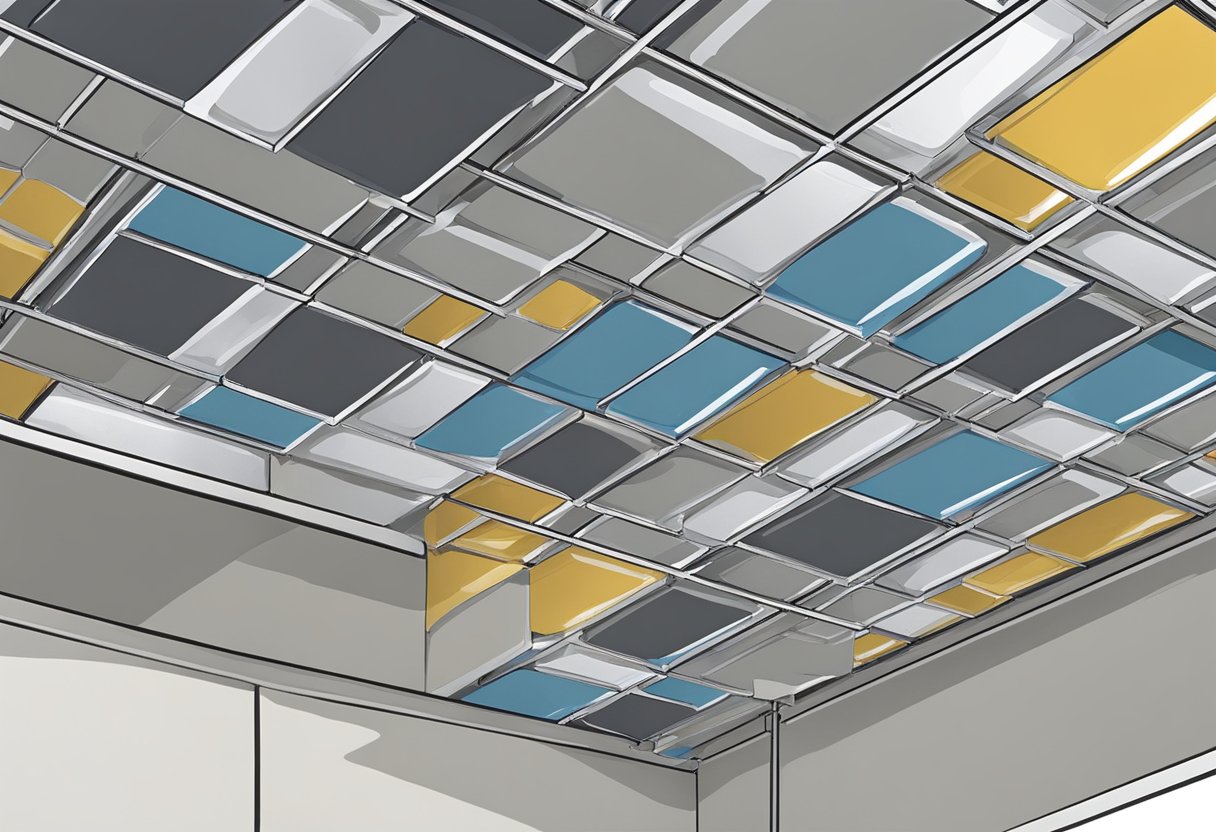If you’re looking to renovate your home or office, one of the most effective ways to spruce up the space is by installing suspended ceiling tiles. These tiles are an affordable and easy way to add a new look to any room while also providing a practical solution for concealing unsightly ductwork, pipes, or wiring. Suspended ceiling tiles are also known as drop ceiling tiles or acoustic ceiling tiles.

Suspended ceiling tiles come in a variety of materials, sizes, and designs, making them a versatile option for any space. Some materials include fiberglass, mineral fiber, and PVC, each with their own unique benefits and drawbacks. Fiberglass tiles are lightweight, durable, and moisture-resistant, while mineral fiber tiles are excellent for soundproofing and fire resistance. PVC tiles are easy to clean and maintain, making them a popular choice for commercial spaces.
Installing suspended ceiling tiles is a straightforward process that can be done by both DIY enthusiasts and professionals. The tiles are designed to fit into a grid system that is suspended from the ceiling, creating a gap between the tiles and the original ceiling. This gap not only provides a space for hiding unsightly elements but also improves acoustic performance and thermal insulation. With a wide range of colors and patterns available, suspended ceiling tiles can be used to create a unique and stylish look that complements any design aesthetic.
Types of Suspended Ceiling Tiles

When it comes to suspended ceiling tiles, there are several types available on the market. Each type has its unique features and benefits. Here are some of the most common types of suspended ceiling tiles:
Mineral Fiber Tiles
Mineral fiber tiles are the most commonly used type of suspended ceiling tiles. They are made from a combination of mineral wool and fibers, which makes them lightweight, durable, and resistant to moisture and fire. These tiles come in a variety of sizes, shapes, and textures, and can be painted to match any decor. Mineral fiber tiles are also known for their excellent acoustic properties, making them ideal for use in spaces where noise reduction is important.
Metal Ceiling Tiles
Metal ceiling tiles are a popular choice for modern and industrial-style interiors. They are made from a variety of metals, including aluminum, steel, and copper, and come in a range of finishes, such as brushed, polished, and powder-coated. Metal ceiling tiles are highly durable and resistant to moisture and fire, making them ideal for use in commercial and industrial spaces. They are also easy to install and maintain and can be used to create a variety of unique designs and patterns.
PVC Ceiling Tiles
PVC ceiling tiles are another popular choice for suspended ceilings. They are made from a type of plastic called polyvinyl chloride (PVC), which makes them lightweight, durable, and easy to clean. PVC ceiling tiles come in a variety of colors, patterns, and textures, and can be used to create a variety of different looks and styles. They are also resistant to moisture and fire, making them ideal for use in kitchens, bathrooms, and other high-moisture areas.
Fiberglass Ceiling Tiles
Fiberglass ceiling tiles are made from a combination of fiberglass and resin, which makes them highly durable and resistant to moisture and fire. They come in a variety of sizes and shapes, and can be painted to match any decor. Fiberglass ceiling tiles are also known for their excellent acoustic properties, making them ideal for use in spaces where noise reduction is important. They are also easy to install and maintain, and can be used to create a variety of unique designs and patterns.
Installation Process

When it comes to installing suspended ceiling tiles, there are a few key steps you need to follow to ensure a successful installation. This section will walk you through the process, from gathering the necessary tools and materials to placing the tiles.
Tools and Materials
Before you begin, you’ll need to gather the following tools and materials:
- Measuring tape
- Chalk line
- Level
- Utility knife
- Tin snips
- Screwdriver
- Ceiling tiles
- Grid system components (main runners, cross tees, wall molding, hanger wire)
Measuring and Planning
The first step in installing a suspended ceiling is to measure the room and plan out the layout. Measure the length and width of the room and determine the height at which you want the ceiling to hang. Use a chalk line to mark the perimeter of the ceiling on the walls.
Next, determine the layout of the grid system. Most systems use a 2-foot by 2-foot or 2-foot by 4-foot grid, so plan accordingly. Use a chalk line to mark the location of the main runners, which will run perpendicular to the joists in the ceiling.
Installing the Grid System
Once you have the layout planned out, it’s time to install the grid system. Begin by installing the wall molding around the perimeter of the ceiling, using screws to secure it to the wall.
Next, install the main runners, starting at one end of the room and working your way across. Use a level to ensure that the runners are straight and level. Cut the runners to size using tin snips.
After the main runners are installed, add the cross tees between them, cutting them to size as needed. The cross tees should fit snugly into the slots in the main runners.
Placing the Tiles
With the grid system in place, it’s time to add the ceiling tiles. Begin by placing the tiles in the corners of the room, working your way inward. Use a utility knife to cut tiles to size as needed.
Once all of the tiles are in place, step back and admire your handiwork! With the right tools and a little bit of know-how, installing suspended ceiling tiles can be a straightforward process that can transform the look of any room.
Benefits of Suspended Ceiling Tiles
If you are considering installing a ceiling in your home or office, you may want to consider suspended ceiling tiles. These tiles offer a range of benefits that make them a popular choice for many people. In this section, we will explore some of the advantages of suspended ceiling tiles.
Acoustic Performance
Suspended ceiling tiles are known for their excellent acoustic performance. These tiles can absorb sound and reduce noise levels, making them ideal for spaces where noise reduction is important. Acoustic ceiling tiles are available in a variety of materials, including mineral wool, fiberglass, and metal, each with its own acoustic properties.
Fire Resistance
Suspended ceiling tiles are also fire-resistant, which makes them a safe choice for any building. These tiles are made from materials that are designed to resist fire, and they can help to prevent the spread of flames and smoke. Some suspended ceiling tiles are even designed to provide additional fire protection, such as those made from mineral wool.
Moisture Resistance
Another benefit of suspended ceiling tiles is their moisture resistance. These tiles are designed to resist moisture and are ideal for use in areas that are prone to dampness, such as bathrooms and basements. Some suspended ceiling tiles are even designed to resist mold and mildew, making them a great choice for areas with high humidity levels.
Aesthetic Options
Suspended ceiling tiles are available in a wide range of styles and colors, making them a versatile choice for any space. Whether you are looking for a classic look or a modern design, there are suspended ceiling tiles to suit your needs. Some tiles even come with decorative patterns or textures, allowing you to create a unique look for your space.
In summary, suspended ceiling tiles offer a range of benefits, including excellent acoustic performance, fire resistance, moisture resistance, and a wide range of aesthetic options. If you are looking for a safe, durable, and attractive ceiling option, suspended ceiling tiles may be the right choice for you.
Maintenance and Repair
When it comes to suspended ceiling tiles, proper maintenance and repair are essential to ensure their longevity and functionality. In this section, we will discuss some tips and techniques for maintaining and repairing your suspended ceiling tiles.
Cleaning Tips
Regular cleaning is crucial to keep your suspended ceiling tiles looking their best. Here are some cleaning tips to follow:
- Use a soft-bristled brush or vacuum with an upholstery attachment to remove dust and loose dirt.
- Always clean in one direction to avoid rubbing dirt or debris into the tile.
- For stubborn dirt, use a clean, white cloth with water or a mild detergent to wipe the tile’s surface.
- Avoid using harsh chemicals or abrasive cleaners as they can damage the tile’s surface.
Tile Replacement
If you notice any damage or wear and tear on your suspended ceiling tiles, it’s important to replace them promptly. Here are some tips for tile replacement:
- Identify the damaged tile and remove it carefully.
- Measure the size of the tile and purchase a replacement that matches its dimensions.
- Install the new tile carefully, making sure it fits snugly into place.
Long-Term Care
To ensure the long-term health of your suspended ceiling tiles, it’s important to follow these care tips:
- Keep the area around the tiles clean and free from debris.
- Avoid hanging heavy objects from the ceiling as they can damage the tiles.
- Check the tiles regularly for signs of damage or wear and tear and replace them as needed.
- Consider hiring a professional to inspect and maintain your suspended ceiling tiles regularly.
By following these maintenance and repair tips, you can keep your suspended ceiling tiles looking their best and functioning properly for years to come.
Regulations and Standards
If you are planning to install or maintain suspended ceiling tile, you must be aware of the regulations and standards that apply to your building. Here are some of the most important ones:
Building Codes
Building codes are a set of regulations that specify the minimum standards for the design, construction, and maintenance of buildings. The International Building Code (IBC) and the National Fire Protection Association (NFPA) Life Safety Code are two of the most widely adopted building codes in the United States. These codes require that suspended ceiling tile meet certain fire-resistance ratings, provide adequate access for maintenance and inspection, and be installed in a way that does not compromise the structural integrity of the building.
Environmental Certifications
If you are concerned about the environmental impact of your building, you may want to consider using suspended ceiling tile that are certified by organizations such as the Forest Stewardship Council (FSC) or the Leadership in Energy and Environmental Design (LEED) program. These certifications ensure that the materials used in the tiles are sustainably sourced and that the manufacturing process meets certain environmental standards.
Health and Safety
Suspended ceiling tile can have an impact on the indoor air quality of your building. If you are concerned about the health and safety of your occupants, you may want to choose tiles that are low-VOC (volatile organic compounds) or that have been tested for emissions. Additionally, if your building is in an area that is prone to earthquakes or other natural disasters, you should choose tiles that are designed to withstand seismic activity.
Overall, it is important to choose suspended ceiling tile that meet the regulations and standards that apply to your building, as well as your own environmental and health and safety concerns.



